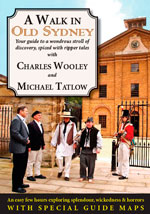
A Walk in Old Sydney
$20.00 per book plus $6.00 postage and packing |
 A lively book launch with Red Coat soldiers from the Hyde Park Barracks and Sydney's Town Crier, Graeme Keating. A Walk in Old Sydney is spiced with several snapshots in time, bringing to life amazing events, such as the invention of a new whip of horrors for lashing convicts, the Rum Rebellion, an encounter with The Argyle Cut Mob and pathos of The Hungry Mile. With special maps and a hundred pictures of Sydney old and new, the book guides you for a few hours, or a day, from Hyde Park, down Macquarie Street, around Circular Quay, all over The Rocks, then to Millers Point, Darling Harbour and Chinatown. Many old secrets are exposed. Snapshot narratives by historian Brian McDonald capture poignant and dramatic events such as the Rum Rebellion.
Did you know?
Book extracts
Apollo, the ancient Greek god of the sun, towers over Diana the Roman huntress with her bow as Greek myth’s Theseus slays the minotaur. Your authors suspect that it is no coincidence that Apollo the pagan was placed extending an arm provocatively towards St Marys Cathedral. In December 1878, a raging rabble of 10,000 racists ranted at Hyde Park against Chinese coming to Australia, bringing Oriental customs they feared, discovering gold the mob reckoned they would have found. Thugs left the park in the night to assault Chinese people around the town and stone and burn their premises.”  The Rocks “This [in George Street, The Rocks] was the site of Scots merchant Robert Campbell’s mansion, Wharf House. His gabled and austere sandstone former warehouse stands at 11 to 31 Hickson Road. The Australasian Steam Navigation Co. bought the corner property in 1876. It commissioned architect William Wardell to design today’s five-level warehouse of brick with Flemish-style gables and a campanile topped with a tapered pyramid spire. Australia’s second bank, The Savings Bank of NSW, also known as “Campbell’s Bank”, was established here in 1819 to encourage convicts to bank their earnings. “With the economy ailing and many unable to find work, Sydney had a rash of optimism when gold was found near Bathurst, beyond the Blue Mountains in the west, in 1851. Hundreds of men rushed to the goldfields on foot and horseback to strike it rich. The prospect of quick wealth lured a lot immigrants to NSW, including the beautiful entertainer Lola Montez, ex-mistress of that fearsome whipper of newspaper editors, Ludwig of Bavaria. Lola also flayed with a whip a critical editor, Henry Seekamp of The Ballarat Times, Victoria. She once confounded a Sydney process server by stripping off all her clothes and daring him to seize her. He fled.”
|

 Take a rest by the glistening Archibald Fountain amid the trees, the focus of Hyde Park, to contemplate on some of the things and past events around here. The bronze statuary, by the way, was a gift to the city by a founder of The Bulletin magazine, J. F. Archibald (1856-1919) to commemorate the bonds between Australia and France during World War I. It is the work of French artist Francois Sicard.
Take a rest by the glistening Archibald Fountain amid the trees, the focus of Hyde Park, to contemplate on some of the things and past events around here. The bronze statuary, by the way, was a gift to the city by a founder of The Bulletin magazine, J. F. Archibald (1856-1919) to commemorate the bonds between Australia and France during World War I. It is the work of French artist Francois Sicard. “In 1900, Bubonic Plague, the Black Death, hit Sydney. Near hysteria swept the settlement. Researchers found out that fleas carried the disease to humans from rats. Rats that, in Sydney’s case, were stowaways on ships from other plague-infected ports.
“In 1900, Bubonic Plague, the Black Death, hit Sydney. Near hysteria swept the settlement. Researchers found out that fleas carried the disease to humans from rats. Rats that, in Sydney’s case, were stowaways on ships from other plague-infected ports. “Here [at Darling Harbour] are some gracious old ladies of the sea, the splendid replica of Cook’s Endeavour, the 1878 square rigger James Craig, the former Navy destroyer Vampire, the Oberon class submarine Onslow, the little hero commando raider of World War II Krait, the former Manly ferry South Steyne which Mike Tatlow commuted on for years, and beyond, the bright red former lighthouse ship Carpentaria. The old girls are usually open for our inspection.”
“Here [at Darling Harbour] are some gracious old ladies of the sea, the splendid replica of Cook’s Endeavour, the 1878 square rigger James Craig, the former Navy destroyer Vampire, the Oberon class submarine Onslow, the little hero commando raider of World War II Krait, the former Manly ferry South Steyne which Mike Tatlow commuted on for years, and beyond, the bright red former lighthouse ship Carpentaria. The old girls are usually open for our inspection.”